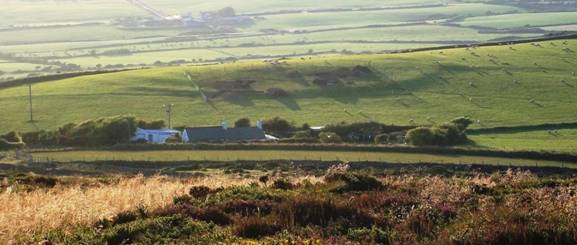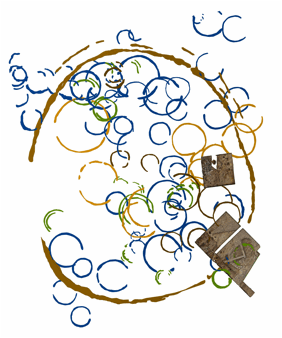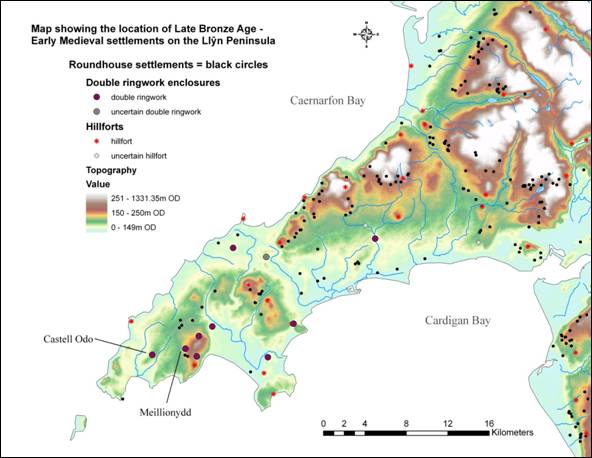The Meillionydd Excavations
This excavation project aims to investigate the chronology, form, character and occupation of the hilltop enclosure of Meillionydd, near Rhiw, on the Llŷn peninsula in northwest Wales.
Meillionydd is a double ringwork enclosure – this is a type of hilltop enclosure that is found mostly on the Llŷn peninsula. These settlements are found on low hilltops and they consist of two circular banks of earth and stone with a handful of internal roundhouses inside. The enclosures are likely to have been the permanent homes of several family groups, and they were places where larger communal gatherings took place.
Our excavation seasons, carried out in July in 2010, 2011, 2012 and 2013 as well as in June and July in 2014 and 2015, have demonstrated that Meillionydd was occupied for a relatively long period of time and that we have evidence for early wooden roundhouses and a ditched enclosure, and later stone roundhouses and concentric enclosure banks. Radiocarbon dating suggests that Meillionydd dates at least from between c. 800 – 200 cal. BC – from the end of the Late Bronze Age to the middle of the Middle Iron Age.

Photograph of Meillionydd, taken from the higher slopes of Mynydd Rhiw in 2011 (photo: Dafydd Davies Hughes).
We have positioned our trenches using a geophysical survey carried out by Gwynedd Archaeological Trust in 2007, which showed several areas of activity and features to target. In the first five seasons, the trenches have been confined to the eastern side of the interior of the enclosure and around the boundaries adjacent to the eastern entranceway. From the 6th season onwards, we are positioning further trenches in a north-westerly direction to get a cross-section of the site. The excavations at Meillionydd are aiming to test whether the site has origins in the ninth and eighth century BC, similar to the nearby double ringwork enclosure of Castell Odo, as well as to:
- gather data on the construction and phasing of the enclosure boundaries;
- assess the sequence of occupation practices within the interior of the enclosure;
- produce dateable materials and provide a chronological sequence for this site and other double ringwork enclosures in the area.
The surveys carried out at Meillionydd
Meillionydd was first investigated in 2007 by George Smith and Dave Hopewell from Gwynedd Archaeological Trust, who undertook a magnetometer survey which defined an oval bivallate embanked enclosure, 105m by 85m, with internal roundhouse platforms located on the inside of the inner bank and in the centre.
A recent GPR survey was carried out by Klaus Loecker and Ray Karl in April 2012 with a team from the Ludwig Boltzmann Institute for Archaeological Prospection Vienna. This produced spectacular results which have provided additional data on the structure and layout of the settlement.

The gradiometer survey by Gwynedd Archaeological Trust. The 2010 trial trenches are shown in red. The 2011 trenches are shown in green, the 2012-2013 trench is shown in blue, the 2014 trenches are shown in yellow, and the 2015 trenches are shown in pink.

The results of the GPR survey carried out in 2012 (from top left to bottom right: the raw data condensed into 30cm slices through the archaeology. The first image shows the raw data for the first 30cm below the topsoil).

This interpretation of the 2012 GPR survey highlights the ditch (brown) and - where possible - different types of roundhouses (blue = unspecified roundhouse, yellow = timber roundhouse & green = stone roundhouse) potentially present on site. Furthermore, it includes Trenches 1, 2 and 3 in different stages of excavation.
Why have we targeted the double ringwork enclosures?
The double ringwork enclosures offer a unique and as yet largely untapped resource for studying the origins of settlement monumentality in the Late Bronze Age and Earliest Iron Age (c. 1000/900 – 600 BC). Despite the presence of ten double ringwork sites on the Llŷn Peninsula, only one has been excavated prior to this project – Castell Odo.
This site was excavated by Leslie Alcock in the 1950s, uncovering a rare and important assemblage of later Bronze Age ceramics, probably dating to c. ninth to seventh centuries BC. The ceramics were deposited within a dark earth artefact-rich deposit (or midden). This humic midden spread around a timber palisade which formed an early timber boundary to the enclosure, and inside were timber roundhouses. The midden and palisade were sealed beneath the earlier Iron Age bank, which was probably constructed in the Early Iron Age, c. sixth – fifth centuries BC, and associated with stone roundhouses.
Our work has indicated that a similar sequence of activity may be present at Meillionydd – as we have identified an earlier ditched or palisaded enclosure which is truncated by the quarry hollow of the later banks. Unfortunately, however, we have not yet discovered any Late Bronze Age ceramics and still need to produce radiocarbon dates for the boundary sequence to determine the dates for each phase.

Map showing the location of the double ringwork sites (purple dots) and hillforts (red stars) on the Llŷn peninsula. The black dots show the location of roundhouse settlements.

 Like the Meillionydd project's Facebook page for updates.
Like the Meillionydd project's Facebook page for updates.